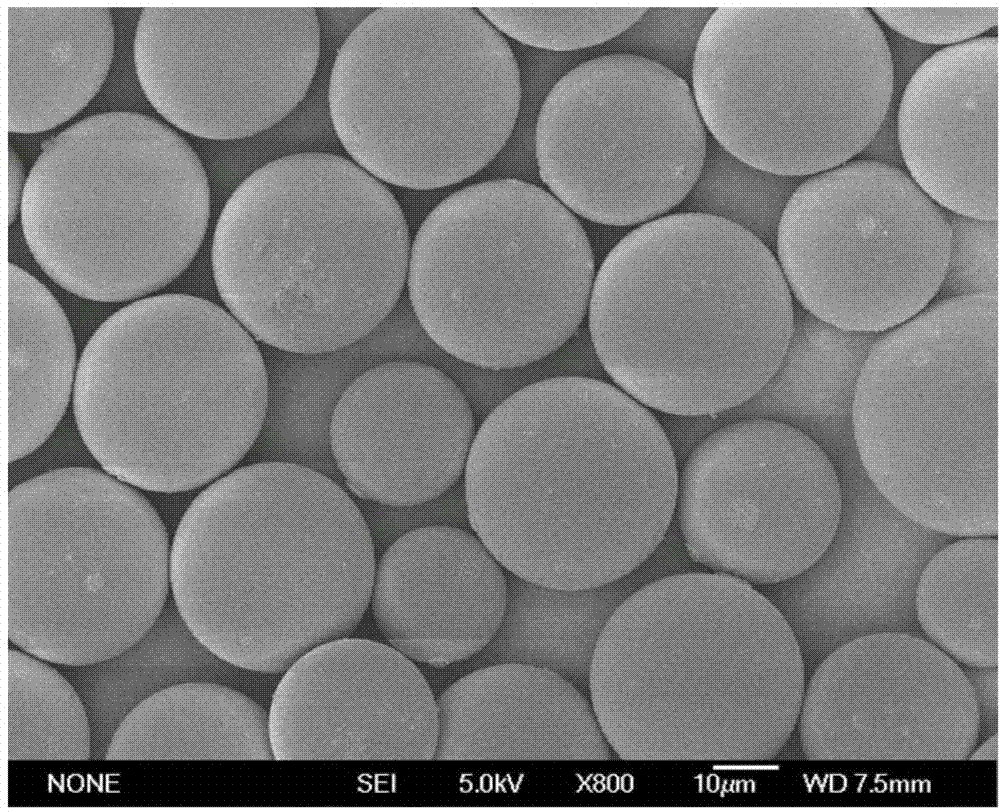Hydrophilic modification method of polystyrene material, and product thereof
A polystyrene-based and styrene-based technology, which is applied in the field of hydrophilic modification of polystyrene-based materials, can solve the problem that hydrophilic macromolecules are difficult to enter into the pores of microspheres, and porous PSt microspheres and PSt microspheres cannot be modified. The pore size of microspheres becomes smaller and other problems, so as to achieve the effect of stable hydrophilic material, reducing hydrophobicity and easy operation.
- Summary
- Abstract
- Description
- Claims
- Application Information
AI Technical Summary
Problems solved by technology
Method used
Image
Examples
Embodiment 1
[0065] Example 1 Preparation of Polystyrene-based (PSt-Cl) Microspheres Containing Active Chlorine on Surface
[0066] Mix 5g of methylstyrene (MST), 0.1g of trichloroethylstyrene, and 1g of divinylbenzene (DVB) as a monomer phase, add 5g of n-heptane (HP), 0.3g of peroxide Dibenzoyl (BPO), dissolved as a dispersed phase. Add 2g of polyvinyl alcohol (PVA) and 0.0015g of dodecylsulfuric acid (SDS) into 100ml of deionized water and dissolve it as the continuous phase. Using conventional membrane emulsification technology (3.5μm membrane pores), the dispersed phase is uniformly dispersed in the continuous phase to form a uniform oil / water emulsion. Then the prepared emulsion was moved into a reactor equipped with a condenser tube, a stirring rod, and a nitrogen conduit, and after replacing oxygen with nitrogen, the microsphere polymerization suspension was obtained after polymerization at 70° C. for 10 h. After the polymerization, the microsphere product was obtained by suc...
Embodiment 2
[0067] Example 2 Preparation of Polystyrene-based (PSt-Cl) Microspheres Containing Active Chlorine on Surface
[0068] Weigh 10g of ethyl styrene (EST), 10g of m-chloromethyl styrene, 0.5g of potassium persulfate (KPS) and mix and dissolve it as the oil phase; add 1.8g of PVA, 0.0004g of SDS and 0.0045g of deionized water to 150ml of deionized water Na 2 SO 4 Completely dissolved as the water phase. Using rapid membrane emulsification technology (2.8μm membrane pores), the oil-water phase mixture is quickly pressed through the microporous membrane tube and circulated emulsified for 5 times to obtain a uniform emulsion. Then the prepared emulsion was moved into a reactor equipped with a condenser tube, a stirring rod, and a nitrogen conduit, and after replacing oxygen with nitrogen, the microsphere polymerization suspension was obtained after a polymerization reaction at 85° C. for 16 hours. After the polymerization, centrifuge at 3000rpm with a centrifuge to obtain the ...
Embodiment 3
[0069] Example 3 Preparation of Polystyrene-based (PSt-Cl) Microspheres Containing Active Chlorine on Surface
[0070] Weigh 1g of styrene (St), 7g of p-chloromethylstyrene (cMSt), 1g of DVB, 0.42g of azoamidine (V65), 3g of hexadecane (HD) and 3g of n-hexanol (HA). Oil phase; add 3.5g PVA, 0.0008g SDS and 0.009g Na to 300ml deionized water 2 SO 4 Completely dissolved as the water phase. Using conventional membrane emulsification technology (5.2μm membrane pores), the oil phase is uniformly dispersed in the water phase to form a uniform oil / water emulsion. Then the prepared emulsion was moved into a reactor equipped with a condenser tube, a stirring rod, and a nitrogen conduit, and after replacing oxygen with nitrogen, the microsphere polymerization suspension was obtained after a polymerization reaction at 80° C. for 20 h. After the polymerization, the microsphere product was obtained by suction filtration with a Buchner funnel. After repeated washing with deionized w...
PUM
| Property | Measurement | Unit |
|---|---|---|
| particle diameter | aaaaa | aaaaa |
| specific surface area | aaaaa | aaaaa |
| particle size | aaaaa | aaaaa |
Abstract
Description
Claims
Application Information
 Login to View More
Login to View More - R&D Engineer
- R&D Manager
- IP Professional
- Industry Leading Data Capabilities
- Powerful AI technology
- Patent DNA Extraction
Browse by: Latest US Patents, China's latest patents, Technical Efficacy Thesaurus, Application Domain, Technology Topic, Popular Technical Reports.
© 2024 PatSnap. All rights reserved.Legal|Privacy policy|Modern Slavery Act Transparency Statement|Sitemap|About US| Contact US: help@patsnap.com










